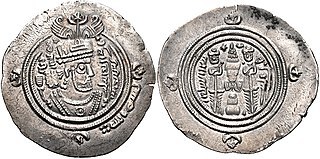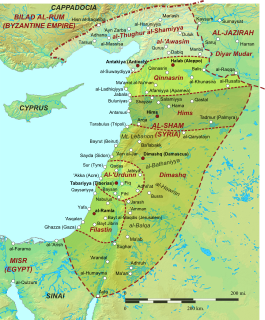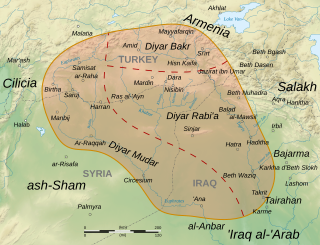
The Umayyad Caliphate was the second of the four major caliphates established after the death of Muhammad. The caliphate was ruled by the Umayyad dynasty. Uthman ibn Affan, the third of the Rashidun caliphs, was also a member of the clan. The family established dynastic, hereditary rule with Muawiya ibn Abi Sufyan, long-time governor of Greater Syria, who became the sixth caliph after the end of the First Fitna in 661. After Mu'awiyah's death in 680, conflicts over the succession resulted in the Second Fitna, and power eventually fell into the hands of Marwan I from another branch of the clan. Greater Syria remained the Umayyads' main power base thereafter, with Damascus serving as their capital.
Mu'awiya I was the founder and first caliph of the Umayyad Caliphate, ruling from 661 until his death. He became caliph less than thirty years after the death of the Islamic prophet Muhammad and immediately after the four Rashidun ('rightly-guided') caliphs. Unlike his predecessors, who had been close, early companions of Muhammad, Mu'awiya was a relatively late follower of the Islamic prophet.
Zionist entity, Zionist regime and Zionist enemy are pejorative terms for the State of Israel which are used by some Arabs and Muslims. Many commentators believe that the terms are used in an attempt to de-legitimize Israel by emphasizing Zionism, the Jewish national movement which led to Israel's founding.

Yazid ibn Mu'awiya ibn Abi Sufyan, commonly known as Yazid I, was the second caliph of the Umayyad Caliphate. He ruled from April 680 until his death in November 683. His appointment was the first hereditary succession to the caliphate in Islamic history. His caliphate was marked by the death of Muhammad's grandson Husayn ibn Ali and the start of the crisis known as the Second Fitna.

Hasan ibn Ali was a prominent early Islamic figure. He was the eldest son of Ali and Fatima and a grandson of the Islamic prophet Muhammad. He briefly ruled as caliph from January 661 until August 661. He is considered the second Shia Imam, succeeding Ali and preceding his brother, Husayn. In Sunni Islam, Hasan is considered as part of Muhammad's family; part of the ahl al-bayt and the ahl al-kisa and he participated in the event of Mubahala. During the caliphate of Ali, Hasan accompanied him in the military campaigns of the First Muslim Civil War. After Ali's assassination in 661, Hasan was subsequently acknowledged caliph in Kufa. His sovereignty was unrecognized by Syria's governor Mu'awiya I, who led an army into Kufa to press the former for abdication. In response, Hasan sent a vanguard under Ubayd Allah ibn al-Abbas to block Mu'awiya's advance until he arrived with the main army. Meanwhile, Hasan was severely wounded in an abortive assassination attempt made by the Kharijites, a faction opposed to both Ali and Mu'awiya. This attack demoralized Hasan's army, and many deserted. On the other hand, Ubayd Allah and most of his troops defected after Mu'awiya bribed him. In August 661 Hasan signed a peace treaty with Mu'awiya on the basis that the latter should rule in compliance with the Quran and the sunna, a council appointed his successor, and his supporters received amnesty. Hasan retired from politics and abdicated in Medina where he eventually died either by a long-term illness or poisoning at the instigation of Mu'awiya, who wanted to install his son Yazid, as his successor.

Bilad al-Sham, often referred to as Islamic Syria or simply Syria in English-language sources, was a province of the Rashidun, Umayyad, Abbasid, and Fatimid caliphates. It roughly corresponded with the Byzantine Diocese of the East, conquered by the Muslims in 634–647. Under the Umayyads (661–750) Bilad al-Sham was the metropolitan province of the Caliphate and different localities throughout the province served as the seats of the Umayyad caliphs and princes.

Jund Filasṭīn was one of the military districts of the Umayyad and Abbasid province of Bilad al-Sham (Levant), organized soon after the Muslim conquest of the Levant in the 630s. Jund Filastin, which encompassed most of Palaestina Prima and Palaestina Tertia, included the newly established city of Ramla as its capital and eleven administrative districts (kura), each ruled from a central town.

The First Fitna was the first civil war in the Islamic community which led to the overthrow of the Rashidun Caliphate and the establishment of the Umayyad Caliphate. The civil war involved three main battles between the fourth Rashidun caliph, Ali, and the rebel groups.
Abd al-Rahman ibn Khalid ibn al-Walid was the governor of Homs under caliphs Uthman and Mu'awiya I. During Mu'awiya's governorship of Syria (639–661), Abd al-Rahman commanded a number of campaigns against the Byzantine Empire and defended the Upper Mesopotamian frontier from the Iraq-based forces of Caliph Ali. He fought reputably against the latter at the Battle of Siffin in 657 and continued his governorship of Homs and campaigns against the Byzantines after Mu'awiya became caliph in 661. His battlefield reputation and descent from his father, the prominent general Khalid ibn al-Walid, made him particularly popular among the Arabs of Syria. Mu'awiya ultimately perceived him as a potential rival of his own son Yazid, who he was grooming as his successor, which led the caliph to allegedly order Abd al-Rahman's poisoning in 666.
Abu Abd Allah al-Mughira ibn Shu'ba ibn Abi Amir ibn Mas'ud al-Thaqafi ; c. 600–671), was a prominent companion of Muhammad and was known as one of the four 'shrewds of the Arabs'. He belonged to the tribe of Thaqif of Ta'if, who were part of the early Islamic elite. He served as governor of Kufa, one of the two principal Arab garrisons and administrative centers of Iraq, under Caliph Umar in 642–645. In his old age, al-Mughira was again made governor of Kufa, serving under the Umayyad caliph Mu'awiya I from 661 until his death in 671. During his second governorship, he ruled with virtual independence from the caliph.
The plague of Amwas, also spelled plague of Emmaus, was a bubonic plague epidemic that afflicted Islamic Syria in 638–639, during the first plague pandemic and toward the end of the Muslim conquest of the region. It was likely a reemergence of the mid-6th-century Plague of Justinian. Called after Amwas in Palestine, the principal camp of the Muslim Arab army, the plague killed up to 25,000 soldiers and their relatives, including most of the army's high command, and caused considerable loss of life and displacement among the indigenous Christians of Syria. The appointment of Mu'awiya ibn Abi Sufyan to the governorship of Syria in the wake of the commanders' deaths paved the way for his establishment of the Umayyad Caliphate in 661, while recurrences of the disease may have contributed to the Umayyad dynasty's downfall in 750. Depopulation in the Syrian countryside may have been a factor in the resettlement of the land by the Arabs unlike in other conquered regions where the Arabs largely secluded themselves to new garrison cities.

Jund Ḥimṣ was one of the military districts of the caliphal province of Syria.
Kharija ibn Hudhafa was a companion of Muhammad and a commander in the Muslim conquest of Egypt during the reign of Caliph Umar. He served as the chief judge and commander of the security forces in Egypt under the governor Amr ibn al-As.

Jurji Zaydan was a prolific Lebanese novelist, journalist, editor and teacher, most noted for his creation of the magazine Al-Hilal, which he used to serialize his twenty three historical novels.

ʿAmr ibn al-ʿĀṣ al-Sahmī was the Arab commander who led the Muslim conquest of Egypt and served as its governor in 640–646 and 658–664. The son of a wealthy Qurayshite, Amr embraced Islam in c. 629 and was assigned important roles in the nascent Muslim community by the Islamic prophet Muhammad. The first caliph Abu Bakr appointed Amr as a commander of the conquest of Syria. He conquered most of Palestine, to which he was appointed governor, and led the Arabs to decisive victories over the Byzantines at the battles of Ajnadayn and Yarmouk in 634 and 636.
Abu al-A'war Amr ibn Sufyan ibn Abd Shams al-Sulami, identified with the Abulathar or Aboubacharos of the Byzantine sources, was an Arab admiral and general, serving in the armies of the Rashidun caliphs Abu Bakr, Umar and Uthman rejecting the fourth Rashidun caliph Ali, instead serving Umayyad caliph Mu'awiyah.

Muḥakkima and al-Haruriyya refer to the Muslims who rejected arbitration between Ali ibn Abi Talib and Mu'awiya at the Battle of Siffin in 657 CE. The name Muḥakkima derives from their slogan la hukma illa li-llah, meaning "judgment (hukm) belongs to God alone". The name al-Haruriyya refers to their withdrawal from Ali's army to the village of Harura' near Kufa. This episode marked the start of the Kharijite movement, and the term muḥakkima is often also applied by extension to later Kharijites.
Busr ibn Abi Artat al-Amiri was a prominent Arab commander in the service of Mu'awiya I, the governor of Islamic Syria (640s–661) and the first Umayyad caliph (661–680). A veteran of the early Muslim conquests in Syria and North Africa, Busr became an ardent partisan of Mu'awiya against Caliph Ali during the First Muslim Civil War. He led a large-scale campaign against Ali's supporters in Arabia, gaining the submission of Medina, Mecca and Ta'if to Mu'awiya's caliphate and carrying out punitive measures against the inhabitants of Yemen. His actions in Arabia, which included executing two young sons of Ali's cousin, the governor of Yemen Ubayd Allah ibn Abbas, and taking captive women from the Muslim tribe of Hamdan, were condemned as unprecedented atrocities by the traditional Muslim sources, particularly Shia Muslim writers.

Al-Jazira, also known as Jazirat Aqur or Iqlim Aqur, was a province of the Rashidun, Umayyad and Abbasid caliphates, spanning at minimum most of Upper Mesopotamia, divided between the districts of Diyar Bakr, Diyar Rabi'a and Diyar Mudar, and at times including Mosul, Arminiya and Adharbayjan as sub-provinces. Following its conquest by the Muslim Arabs in 639/40, it became an administrative unit attached to the larger district of Jund Hims. It was separated from Hims during the reigns of caliphs Mu'awiya I or Yazid I and came under the jurisdiction of Jund Qinnasrin. It was made its own province in 692 by Caliph Abd al-Malik. After 702, it frequently came to span the key districts of Arminiya and Adharbayjan along the Caliphate's northern frontier, making it a super-province. The predominance of Arabs from the Qays/Mudar and Rabi'a groups made it a major recruitment pool of tribesmen for the Umayyad armies and the troops of the Jazira played a key military role under the Umayyad caliphs in the 8th century, peaking under the last Umayyad caliph, Marwan II, until the toppling of the Umayyads by the Abbasids in 750.
Junada ibn Abi Umayya al-Azdi was a Syria-based commander of naval and land forces under the Umayyad caliph Mu'awiya I and a transmitter of hadiths.








